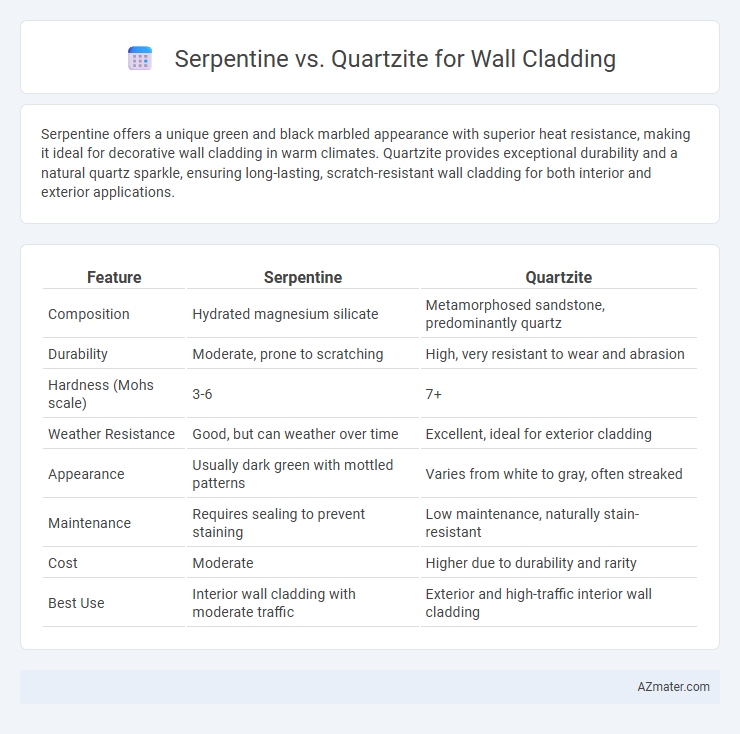Serpentine offers a unique green and black marbled appearance with superior heat resistance, making it ideal for decorative wall cladding in warm climates. Quartzite provides exceptional durability and a natural quartz sparkle, ensuring long-lasting, scratch-resistant wall cladding for both interior and exterior applications.
Table of Comparison
| Feature | Serpentine | Quartzite |
|---|---|---|
| Composition | Hydrated magnesium silicate | Metamorphosed sandstone, predominantly quartz |
| Durability | Moderate, prone to scratching | High, very resistant to wear and abrasion |
| Hardness (Mohs scale) | 3-6 | 7+ |
| Weather Resistance | Good, but can weather over time | Excellent, ideal for exterior cladding |
| Appearance | Usually dark green with mottled patterns | Varies from white to gray, often streaked |
| Maintenance | Requires sealing to prevent staining | Low maintenance, naturally stain-resistant |
| Cost | Moderate | Higher due to durability and rarity |
| Best Use | Interior wall cladding with moderate traffic | Exterior and high-traffic interior wall cladding |
Introduction to Serpentine and Quartzite
Serpentine is a metamorphic rock known for its rich green hues and smooth, waxy texture, making it a popular choice for decorative wall cladding. Quartzite, a highly durable metamorphic rock formed from quartz sandstone, offers strikingly hard surfaces with a range of colors from white to pink and red tones. Both materials exhibit excellent weather resistance and unique aesthetic qualities, influencing their selection in architectural applications for wall cladding.
Geological Origins and Composition
Serpentine and quartzite differ significantly in geological origins, with serpentine forming from the metamorphism of ultramafic rocks rich in magnesium and iron, while quartzite originates from the metamorphism of pure quartz sandstone. Serpentine's composition includes minerals like antigorite, lizardite, and chrysotile, giving it a distinctive green hue and smooth texture, whereas quartzite consists almost entirely of interlocking quartz grains, resulting in exceptional hardness and resistance to weathering. These compositional differences influence their suitability for wall cladding, with serpentine offering unique aesthetic appeal and quartzite providing superior durability.
Visual Aesthetics: Color and Texture Comparison
Serpentine offers a rich palette of deep greens and variegated patterns, creating a visually striking wall cladding with a smooth to slightly fibrous texture that enhances natural movement. Quartzite features a more subtle, crystalline appearance with colors ranging from soft whites and grays to warm browns, providing a refined texture that is both dense and grainy. The contrast in color intensity and surface texture between serpentine and quartzite allows designers to select based on desired boldness or understated elegance in wall cladding projects.
Durability and Strength Factors
Serpentine exhibits moderate durability with resistance to weathering but is softer and less dense compared to quartzite, making it more prone to scratches and surface wear in high-traffic wall cladding applications. Quartzite offers superior strength and hardness, ranking around 7 on the Mohs scale, ensuring long-lasting resistance to impact, abrasion, and environmental stress. For wall cladding where durability and structural integrity are critical, quartzite provides a more robust and enduring surface than serpentine.
Resistance to Weather and Environmental Conditions
Serpentine offers moderate resistance to weather and environmental conditions, but it is more prone to weathering and chemical alteration due to its softer mineral composition and higher susceptibility to acid rain. Quartzite provides superior durability and weather resistance, maintaining its structural integrity and color over time even under harsh environmental exposure, thanks to its dense, hard silica composition. For wall cladding applications, quartzite is preferable in areas with extreme weather, while serpentine may require additional sealing and maintenance to preserve its appearance.
Maintenance & Cleaning Requirements
Serpentine wall cladding requires gentle cleaning with pH-neutral detergents and soft cloths to prevent surface damage and maintain its vibrant color. Quartzite, known for its durability and resistance to staining, can withstand regular cleaning with mild soap and water, making maintenance easier and less frequent. Both materials benefit from periodic sealing, but quartzite generally demands less intensive upkeep due to its harder, non-porous surface.
Installation Ease and Techniques
Serpentine offers greater ease of installation for wall cladding due to its softer texture and lighter weight, allowing for quicker cutting and shaping with standard tools. Quartzite requires specialized equipment and skilled labor because of its hardness and density, which prolongs installation time and increases labor costs. Techniques for serpentine often include adhesive bonding and mechanical anchors, whereas quartzite typically demands reinforced support systems to manage its heavier load on walls.
Cost Analysis: Serpentine vs Quartzite
Serpentine offers a cost-effective solution for wall cladding due to its abundant availability and lower quarrying expenses, making it suitable for budget-conscious projects. Quartzite, while generally more expensive, commands a higher price because of its superior hardness, durability, and aesthetic appeal, often leading to lower maintenance costs over time. Evaluating long-term investment versus initial outlay is essential when choosing between Serpentine and Quartzite for cladding applications.
Sustainability and Environmental Impact
Serpentine and quartzite both offer sustainable options for wall cladding, with serpentine being valued for its lower energy consumption due to easier quarrying and processing methods. Quartzite exhibits exceptional durability and resistance to weathering, reducing the need for frequent replacement and contributing to long-term environmental benefits. Choosing locally sourced variants of either stone minimizes transportation emissions, further enhancing their ecological footprint.
Best Applications and Suitability for Wall Cladding
Serpentine offers excellent durability and a unique greenish hue, making it highly suitable for decorative wall cladding in residential and commercial interiors where aesthetic appeal is paramount. Quartzite's superior hardness and resistance to weathering make it ideal for exterior wall cladding, especially in environments exposed to harsh weather conditions and high traffic. Both materials provide natural stone elegance, but Quartzite outperforms Serpentine in structural strength and longevity for outdoor applications.

Infographic: Serpentine vs Quartzite for Wall Cladding
 azmater.com
azmater.com